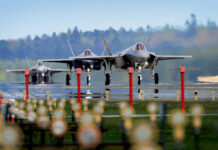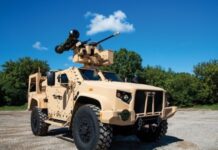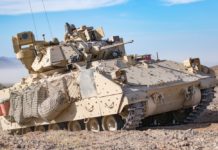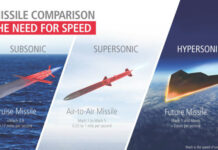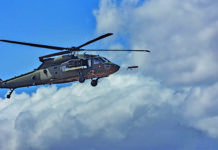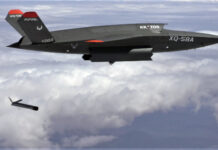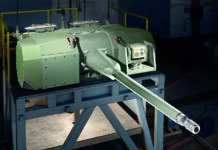Steady replenishment of consumables – including food, munitions and spare parts – is essential to maintaining combat capability. This vital mission is accomplished by tactical trucks, also known as tactical logistics vehicles or simply as supply trucks.
These wheeled, off-road capable cargo carriers form the long-range link between strategic ports and regional supply depots, as well as the medium- to short-range link between supply depots and dumps for the frontline forces. This resupply mission can extend all the way onto the extended battlefield, typically to within one to four kilometres of the fighting units. Land forces worldwide – including in North America and Europe – are modernising their tactical logistics fleets to improve efficiency and enhance the ability to sustain operational forces in the field.
North America
The United States Army’s Common Tactical Truck (CTT) programme aims to replace the various medium- and heavy-lift truck models currently in service with a single modular vehicle system. According to Army planning statements, the vehicles are to supply combat and combat support units across all tactical mobility levels as far forward as mission, enemy, troops, terrain, time and civil considerations allow. Operations must be conducted on road and cross-country, around the clock and in all climate zones.
Five CTT variants are planned:
- Load Handling System
- Off Road Tractor
- Line Haul Tractor
- Fuel Carrier
- Cargo Carrier
These variants will perform all supply mission categories including – but not limited to – containerised cargo, bridging equipment, and breakbulk cargo. They will replace the current:
- Palletised Load System (PLS)
- M1088 Medium Tactical Vehicle Tractor
- M915 Line Haul Tractor
- Heavy Expanded Mobility Tactical Truck (HEMTT)
The US Army Common Tactical Truck
The Load Handling System (LHS) will be required to load, transport and offload a wide variety of flatrack types as well as ISO containers, engineering mission modules, and fuel tanks and pump modules. Minimum payload capacity is 16,477 kg, in addition to towing a palletised load trailer. The Off Road Tractor (ORT) will tow a variety of flatbed and lowbed semitrailers with up to 40 tons capacity, including trailer-mounted vans and fuel tanks.
The Line Haul Tractor (LHT) will be restricted to on-road operations. It will tow flatbed semitrailers and tanker trailers at highway speeds.
The Tanker Truck (TT) will carry and dispense a minimum of 9,464 litres of fuel, and can tow a trailer with an additional fuel tank. The tanker will dispense a variety of fuels directly to aircraft and vehicles, or transfer fuel to other tankers or to fuel dispensing stations. The Cargo variant (CV) will primarily carry munitions and have a minimum capacity of 10,000 kg. Additionally the truck can tow a trailer with additional cargo. Loads can include either eight standard transport pallets or four MLRS rocket pods. An on-board crane will load and unload cargo.
CTT Features
The CTT family of vehicles will be based on modified Commercial, Off-The-Shelf (COTS) vehicles and will incorporate modern and emerging technologies and capabilities not found in legacy military trucks. This will permit more efficient integration with other state-of-the-art and developmental tactical vehicles and communication, command and control systems. Modularity will enable frequent exchange or upgrade of vehicle components and systems to ensure the trucks remain state-of-the-art over their service life.
The Army aspires to retain as much commonality as possible with the civilian variants of the new trucks, to ensure access to market-priced replacement and upgrade components, thereby reducing lifecycle costs. Choosing a common core vehicle using the same chassis, powertrain and transmission will also simplify maintenance. Regarding maintenance, CTT will also be equipped with AI vehicle health monitoring and diagnostics to enable targeted proactive repairs before components fail.
Requirements
An abbreviated draft version of the CTT Specifications document presented to industry on 6 October 2021 was also released publicly. Among the requirements are:
- air-mobility (C-5, C-17)
- sea-mobility (Roll-On, Roll-Off vessels)
- off-road capability
- the ability to operate in degraded or denied environments
- a minimum unrefuelled range of 500 km off-road and 640 km on-road
- Artificial Intelligence aided operation
- optionally unmanned operation including fully automated loading/offloading of cargo
- digital drive-by-wire controls
- the potential for converting the vehicles to hybrid or electric drive in the future
In November 2021, the Army clarified that it has not yet decided whether the CTT design needs to support a conversion to full electric drive.
Commercially available Advanced Driver Assist Systems (ADAS) should be incorporated in CTT to enhance safety. This includes:
- lane departure warning (LDW)
- lane keeping
- adaptive cruise control (ACC)
- blind spot monitoring
- collision warning
- collision avoidance
- stability control
- advanced driving behaviour analytics
- and 360 degree surround view
The draft specifications also require that “ADAS and safety systems incorporating Vehicle Control Intervention Technology that may interfere with the mission must provide manual shut off, automatic shut off, or driver override for wartime operations.”
CTT Alterations
Specifically military aspects of the CTT will provide force protection. These include a fully armoured replaceable cab (plus under-wheel, underbody and fuel tank protection) and/or the ability to accept modular armour up to MRAP level; a common remotely operated weapon station (CROWS) and an Objective Gunner Protection Kit. Furthermore, the vehicle should be designed to withstand Chemical, Biological, Radiological and Nuclear (CBRN) contamination and decontamination, as well as the effects of High Altitude Electromagnetic Pulse (HEMP).
The Army intends to pursue a rapid acquisition strategy. The request for proposals (RfP) for prototype development is expected during the third quarter of Fiscal Year 2022 (FY2022). The prototyping contract award is expected during the fourth quarter of FY2022 or early in FY2023. The Army is expected to issue prototyping contracts to three firms. The competition is open to foreign manufacturers. Foreign built prototypes may be submitted for the assessment phase. However, serial production of the CTT would have to take place in the US if a foreign manufacturer wins the competition.
Prototype delivery and assessment could take place during FY2024, with a likely production contract award in FY2025. CTT fielding is projected to begin in Fiscal Year 2028. The US Army’s current medium and heavy lift fleet comprises approximately 30,000 vehicles. It is currently unclear whether CTT will replace these trucks on a one-to-one basis. The new truck is required to have a minimum useful economic life of 30 years, with an objective life of 40 years.
Canadian Armed Forces Logistics Vehicle Modernisation
The Canadian armed forces effectively completed their Medium Support Vehicle System (MSVS) modernisation programme in Spring 2021. The programme began in 2009 with a contract award to Navistar International for 1,300 Military Commercial Off-The-Shelf (MILCOTS) trucks which were delivered through 2011. The vehicles were derived from the firm’s International WorkStar 7400 civilian truck, and were provided in six different configurations. Three of these were cargo transport versions totalling 360 vehicles. All MILCOTS trucks were assigned to the reserve forces for domestic operations only.
An additional order for 1,500 Standard Military Pattern (SMP) trucks (plus 300 trailers and 150 armoured protection systems) was awarded to Mack Defense in 2015. Final deliveries in 2020 brought the procurement total to 1,587 SMP trucks and 322 trailers, all assigned to the Regular Army. The SMP, which is based on the Renault KERAX 8×8 truck, achieved Full Operational Capability (FOC) in February 2021.
LMV
A new Logistics Vehicle Modernisation (LVM) Project was approved by Parliament in 2019. The LVM project will procure both light (4 to 5 ton) and heavy (16.5+ ton) logistics vehicles to replace the current fleet, which is reaching the end of its service life. In addition to vehicles the project will also acquire trailers, special-purpose containers and modules, material handling systems, and bulk fuel and water containers. An RfP for the first two truck types (both classified as “Medium” in the document) was released in October 2021.
Both require a conventional cab and chassis, a heavy duty box van for cargo, a 4×2 drivetrain and dual rear wheels. Medium Truck 001 requires a minimum payload capacity of 2,727 kg. Minimum van dimensions are 492 cm long by 244 cm wide by 234 cm high. Medium Truck 002 requires a 5,455 kg cargo capacity and van dimensions of 369 x 259 x 264 cm.
Seven supplier teams had qualified in 2019 to compete for the contract:
- Daimler AG (withdrew in September 2020)
- General Dynamics Land Systems – Canada Corporation and General Dynamics Land Systems, Inc.)
- Iveco Defence Vehicles S.p.A.
- Mack Defence LLC
- Navistar Defence LLC
- Oshkosh Defence Canada Incorporated and Oshkosh Defence, LLC
- Rheinmetall Canada Inc. and Rheinmetall MAN Military Vehicles (RMMV) GmbH.
Under current planning, project approval and contract award are expected in the 2023/2024 timeframe. First delivery is expected as early as 2026/2027, with final delivery in 2030/2031. The vehicles will have an expected service life of 20-30 years. As it is based on COTS systems, the LMV project is classified as low risk, although the state of the current fleet does exert some pressure to remain within the target timeline.
European Programmes
Several reset programmes are also underway in Europe.
Germany – UTF/GTF
The German armed forces are investing in new unprotected transport vehicles (Ungeschützte Transportfahrzeuge – UTF) to meet the increased demands of domestic and out-of-area operations. The UTF family includes 6×6 vehicles with 5-7 ton payload capacity, and 8×8 vehicles with up to 14,200 kg capacity. Cargo can be transported on flatracks or in containers; the trucks can also be equipped to transport fuel. Built by RMMV, the HX2 series trucks can traverse unimproved and damaged roads, but – thanks in part to the low-torsion ladder frame and robust leaf spring suspension – are also capable of heavy-duty off-road operations.
According to the German Army, the trucks can even keep pace with Main Battle Tanks in the field. Off-road performance includes the ability to climb a 60 per cent gradient and ford 1.6 metres of water. A remotely operated weapon station can be mounted atop the cab. When operationally necessary the unarmoured cab can be swapped with an armoured cab. The first of 3,271 planned vehicles were delivered in 2018; the final tranche is expected to be completed by the end of 2022. Army leaders have indicated a future demand for at least 3,000 more UTF-type logistics vehicles.
Additionally, the German MoD awarded RMMV a separate contract in 2020 for delivery of 4,000 Load Handling System trucks based on the HX2 8×8 variant. The contract is to be fulfilled through 2025. In January 2021, the German military’s procurement office awarded Iveco Defence a contract for 1,048 protected trucks (GFT – Geschütztes Fahrzeug) with a delivery window of 2021-2028.
The first tranche consists of 224 units based on Iveco’s militarised 8×8 TRAKKER truck, to be supplied in five variants. The vehicles feature armoured cabs offering best-in-class ballistic, mine, IED and NBC protection. Some will be equipped with hydraulic cranes and winches. Payload capacity is 15 tons.
Britain – EPLS MK3
The British Army acquired approximately 7,500 Logistic Support Vehicles (LSV) from RMMV in the 2008-2013 timeframe. Some 90 per cent of these trucks belong to the HX family. The five variants include cargo trucks with 6, 9 and 15 ton capacity as well as unit support tankers and recovery vehicles. According to the British MoD, the new LSV provide far greater mobility than previous generation cargo vehicles and can be fitted with armour, communications and ECM equipment, and a 7.62 mm machine gun.
In the Spring of 2021 the Army completed acquisition of the Enhanced Pallet Load System (EPLS) MK3 which is based on the 15-ton LSV variant. Equipped with a HIAB hook lift, the EPLS can accommodate a 16-ton flatrack payload or comparable cargo loads, and enable rapid loading and unloading in the field. Alternately it can lift and carry a six metre ISO container without loading it onto a flatrack. As described by the MoD, this procurement satisfies the requirement for a versatile medium lift capability to provide the next generation of materiel distribution across the battlefield, and in multiple operating environments. In total, 382 EPLS MK3 are being created through conversion of 15-ton LSV trucks already in service. The work is performed by RMMV’s subsidiary MAN Truck and Bus UK Ltd.
France – PPLOG
The Porteur Polyvalent LOGistique (“Multipurpose Logistics Carrier” PPLOG) is the supply “workhorse” of the French Army. More than half of the ordered units feature armoured cabs with ballistic and mine blast protection. A manned ring-mount weapon station is situated atop the cab. The climate-controlled cab can accommodate a range of military communication and command systems as well as an electronic countermeasures system. The 8×8 truck has an autonomous articulated hook-lift loading system mounted behind the cabin, and up to 16,000 kg carrying capacity. The vehicle is all-terrain capable (including snow covered mountain roads), and is suited to all climate zones.
The PPLOG is part of the French Army’s Porteur Polyvalent Terristrière, (PPT – Multipurpose Land Carrier) programme conceived in 2010. In addition to the PPLOG (which forms the majority of the planned acquisition), the PPT programme also includes a recovery vehicle and an engineering vehicle. All three are based on the Iveco Defence M320.45 truck chassis, and assembled in France by Soframe. The French Army took possession of the first units in 2013. A total of 2,400 PPT units is planned. The state of the art transport system has also been exported to several countries.
Netherlands – DVOW
The Netherlands is conducting the Defensiebrede Vervanging Operationele Wielvoertuigen (DVOW) or “Joint Replacement Programme – Wheeled Vehicles.” This broad programme includes replacement of the DAF logistics vehicles with 2,800 Scania GRYPHUS trucks, which are derived from the civilian Scania XT which was launched in 2017. The new vehicles feature significantly improved off-road capability and modern vetronics. The modular trucks can be configured for a broad spectrum of missions, from cargo to personnel transport.
Some will be equipped with a crane located behind the cab. Depending on mission requirements, the unarmoured cab can be replaced with a fully armoured one. Other improvements over the previous vehicles include a driver assist package and a 360-degree situational awareness system. To reduce damage to the environment, the GRYPHUS is equipped with AdBlue, which is released into the vehicle exhaust to break down harmful nitrogen oxide into its harmless components.
More Dutch Requirements
The land forces will receive 2,400 vehicles, with the remainder supporting the other services. A total of 2,500 trucks will come in the standard 8×8 configuration with a 10 ton cargo capacity, with the remainder being 6×6 and 4×4 vehicles. The vehicles are modular, and can be mission configured, including optional mounting of cranes, generators, and/or containers. The larger trucks feature weapons mounts, electronic countermeasures, military-grade communications suites, infrared lighting, camera mounts for 360 degree situational awareness, and camouflage patterns.
The unarmoured truck cabs can be exchanged for armoured cabs when required. 185 armoured cabs are being procured from Centigon for this purpose. The procurement programme also provides for 1,600 general and mission-specific containers or modules to be provided by Marshall Aerospace & Defence Group (Canada). Many of these modules will be permanently mounted on the 8×8 GRYPHUS variants.
The 6×6 trucks come in two variants. The light version have a 10-ton capacity, but are not militarised; they will be used for ground transport at military airfields. The heavy 6×6 trucks have a 15-ton capacity. The 4×4 trucks have a five-ton capacity; they will primarily be assigned to the Marine Corps. Initial deliveries began in early 2021. Final deliveries under the DVOW programme are slated for 2026.
Future Trend Toward Automation
A major feature likely to become standard, at least among leading armed forces, is vehicle autonomy. When RMMV’s newest vehicle generation, the HX3 series, rolled out in May 2021 RMMV’s CEO Ludwig Ostler quickly dubbed it “the future tactical truck.” Among its attributes were ADAS as well as optionally semi-autonomous and fully autonomous operation. The ADAS include Emergency Brake Assist (EBA), ACC and LDW, all of which contribute to safety by mitigating driver fatigue and compensating for difficult driving conditions.
With the proper interface, ADAS can be enhanced further to enable vehicle autonomy. Recent experiments conducted by the US Army have proven the viability of leader-follower operations, with manned trucks at the head of a convoy guiding up to nine unmanned vehicles. Successful US Army experiments were conducted in both urban and open country settings in the 2018-2020 timeframe. Building on this experience, the Army Futures Command has established a multi-year capabilities development programme as part of the autonomous ground resupply science and technology objective.
Beyond ADAS
In September 2020, a yearlong operational technical demonstration (OTD) was launched by supplying Leader-Follower Tactical Wheeled Vehicle (LF/TWV) technology kits to every truck in the 41st Transportation Company at Fort Polk, Louisiana. The demonstration will test the technology as well as determine future training and doctrine requirements for semi-autonomous operations. Beginning in 2023, an additional five companies will receive the LF/TWV conversion kits. Initially the units will train to operate Leader-Follower convoys with four autonomous vehicles, advancing to the full 1:9 manned-unmanned vehicle ratio by the 2030s.
Fully autonomous supply missions are considered the logical next step, especially in support of highly dispersed units. Such missions would permit deployment of single vehicles (perhaps escorted by armed unmanned security vehicles) without exposing human crews to enemy fire or capture. Implementing such a capability will require further advances in artificial intelligence.








